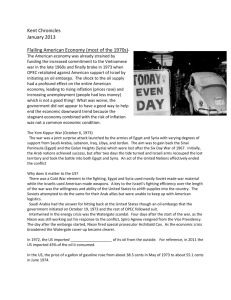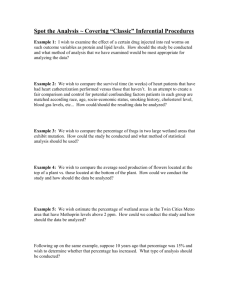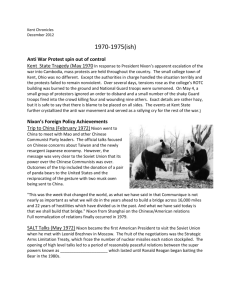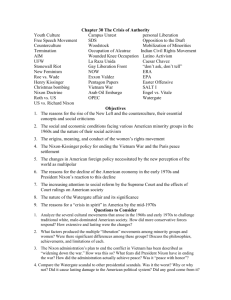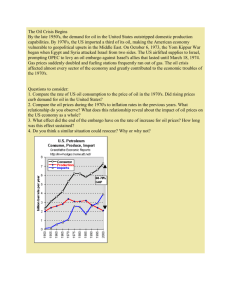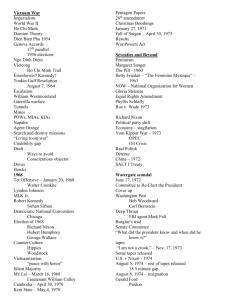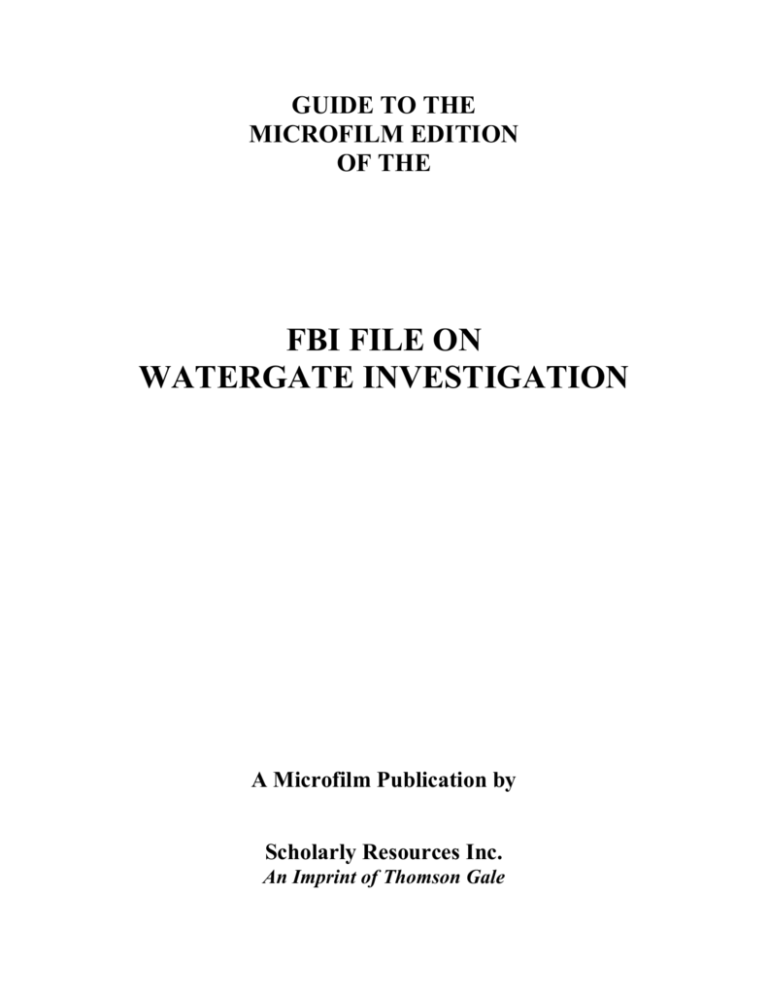
GUIDE TO THE
MICROFILM EDITION
OF THE
FBI FILE ON
WATERGATE INVESTIGATION
A Microfilm Publication by
Scholarly Resources Inc.
An Imprint of Thomson Gale
Scholarly Resources Inc.
An Imprint of Thomson Gale
12 Lunar Drive, Woodbridge, CT 06525
Tel: (800) 444-0799 and (203) 397-2600
Fax: (203) 397-3893
P.O. Box 45, Reading, England
Tel: (+44) 1734-583247
Fax: (+44) 1734-394334
ISBN: 1-57803-315-2
All rights reserved, including those to
reproduce this microfilm guide or any parts
thereof in any form
Printed and bound in the
United States of America
2005
Table of Contents
Publisher’s Note, iv
Introduction to the Collection, v
Reel Notes for FBI File on Watergate Investigation, 1
Publisher’s Note
The microfilm publication of the Federal Bureau of Investigation Files is produced with
the cooperation of the FBI, Washington, DC. This material was released by the FBI under
provision of the Freedom of Information Act. The publisher does not claim copyright to
the materials comprising this collection or to the accompanying guide.
Scholarly Resources, Inc. has reproduced the Watergate Investigation FBI Files in the
exact order as supplied by the FBI. Pages may be missing from some files, some files
may be out of order, or other files may be duplicates. Individual sections are identified by
the FBI’s filing nomenclature.
Quality of filmed material: This microfilm edition of the Watergate FBI Investigation
Files faithfully reflects the visual quality of material received from the FBI. Some pages
received were very poor quality electrostatic reproductions.
Several hundred FBI deleted page information sheets, stating that the documents were
already processed earlier in release may be found in Sections 1-15, 17, 19-20, 23, 29-31,
41, 45, and 49 have been removed from Volumes 1-9 and 14.
iv
Introduction
On the evening of June 16, 1972, a security guard at the Watergate Hotel in Washington,
D.C., discovered a piece of tape on the lock of the door that led to the National
Democratic Headquarters and set off a chain of events that would, ultimately, bring down
the presidency of Richard Milhous Nixon. Afterwards, Americans would wonder why
Nixon and the Republican Party risked so much on such a minor event when Nixon was
leading in the election polls, and the Democratic Party was in disarray. Indeed, Nixon
would go on to win the presidency by a landslide, with 520 electoral votes. Only 270
electoral votes are needed to win the presidency.
The break-in at the Watergate was only part of a larger campaign designed by Nixon
supporters to rattle Democratic candidates and tarnish the reputation of the whole party.
This campaign included harassment of Democratic candidates, negative campaign ads,
two separate break-ins at the National Democratic Headquarters, and an additional breakin at Daniel Ellsberg's psychiatrist's office. Ellsberg was the individual who offered up
the "Pentagon Papers" for public consumption, detailing the strategy--or lack of it--for
the United States' position in Vietnam.
Theodore H. White, chronicler of presidents from Dwight Eisenhower to Ronald Reagan,
points out in Breach of Faith that the Watergate break-in was riddled with mistakes. G.
Gordon Liddy, advisor to Richard Nixon, had been given $83,000 from Nixon's
Committee to Re-Elect the President (CREEP) to provide the necessary equipment. When
the tape was placed over the lock, it was placed horizontally rather than vertically, which
made it more noticeable. The tape had been spotted earlier in the day and removed by a
security guard. It was replaced in the same position. Since only outside personnel were
used for the break-in, they were easy to spot as not belonging in the Watergate. The
electronic surveillance equipment purchased by Liddy was inferior and had no cut-off
between those conducting the actual break-in and those listening in another hotel across
the street. When the break-in was discovered, the police were led to Howard Hunt and
Liddy in a hotel across the street. Furthermore, all participants had retained their own
identification papers.
Instead of being honest with the American public and taking his advisors to task, Richard
Nixon immediately became embroiled in a cover-up that would slowly unravel over the
next two years--leading to Nixon's resignation in August 1974. As the facts surrounding
the break-in were made known, it was revealed that the Nixon presidency had been
involved in serious manipulation and abuse of power for years. It seemed that millions of
dollars coming from Nixon supporters had been used to pay hush money in an ill-advised
attempt to hide the truth from Congress and the American people. Richard Nixon, it was
discovered, truly lived up to his nickname of "Tricky Dick."
During the investigation, the names of Richard Nixon's advisors would become as well
known to the American people as those of Hollywood celebrities or sports heroes. Chief
among these new celebrities were close friends of the President: John Ehrlichman and
Bob Haldeman. Ehrlichman served as the President and Chief of the Domestic Council
v
while Haldeman acted as Chief of Staff. Both would be fired in a desperate attempt to
save the presidency. Another major player was John Dean, the young and ambitious
Counsel to the President. John Mitchell, the Attorney General, and his wife Martha
provided color for the developing story. Rosemary Woods, the president's personal
secretary, stood loyally by as investigators kept demanding answers to two questions:
"What did the president know?" and "When did he know it?" The answers to the two
questions provided the crux of the investigation. If it had been proved that Nixon was the
victim of over-enthusiastic supporters rather than a chief player in the entire scenario, his
presidency would have survived. When Nixon learned of the break-in was integral to
understanding his part, if any, in the subsequent cover-up.
An investigation revealed that Nixon knew about the break-in from the beginning and
that he was involved in the cover-up as it progressed. When the Nixon presidency was
over, James David Barber, political scientist and author of The Presidential Character,
detailed its crimes: "Making secret war; Developing secret agreements to sell weapons to
enemy nations; Supporting terroristic governments; Helping to overthrow progressive
governments; Receiving bribes; Selling high political offices; Recruiting secret White
House police force; Impounding sums of money appropriated by Congress; Subverting
the electoral, judicial, legal, tax, and free speech systems; and Lying to just about
everyone."
In the early days of the Watergate investigation, most forms of media reported the breakin as a minor story with little national significance. However, two aggressive young
reporters who worked for The Washington Post began to dig deeper into the background
surrounding the actual crime. Aided by an informant, who would be identified only as
"Deep Throat," Carl Bernstein and Bob Woodward uncovered one of the major stories of
the twentieth century and became instrumental in forcing the first presidential resignation
in American history.
As Congress began to hold congressional hearings, Alexander Butterfield, a Nixon
presidential aide, revealed that a complex taping system had been installed to record
conversations in the Oval Office, Camp David, the Cabinet rooms, and Nixon's hideaway
office. Nixon's distrust of others would prove to be his own undoing. He fought to
maintain control over the tapes and went so far as to fire a number of White House
officials in what became known as the "Saturday Night Massacre." The Supreme Court
did not accept Nixon's argument that the tapes contained only private conversations
between the president and his advisors and, as such, were protected by executive
privilege. From the time in 1974 that the Court in U.S. v. Nixon ordered the president to
release the tapes, it was widely accepted that Nixon had lost the presidency.
The tapes released in the 1970s contained 18 minutes of silence that have never been
explained. In 1996 the lawsuit of historian Stanley I. Kutler and the advocacy group
Public Citizen resulted in the release of over 200 additional hours of tape. In Abuse of
Power: The New Nixon Tapes, Kutler writes that the new information reveals that Nixon
was intimately involved both before and after Watergate in abuses of power. A taped
conversation on June 23, 1972, proved that Nixon and Haldeman talked about using the
vi
CIA to thwart the FBI investigation into the cover-up. When the New York Times
published the "Pentagon Papers," Nixon told his advisors: "We're up against an enemy
conspiracy. They're using any means. We're going to use any means." This conversation
goes a long way in illustrating Nixon's paranoia and his adversarial relationship with the
American citizenry. It also points out his belief in his own invincibility.
In mid-1974, after Nixon had been named an unindicted co-conspirator in the Watergate
affair, the House of Representatives approved the following articles of impeachment:
Article I: Obstruction of justice; Article II: Abuse of power; and Article III: Defiance of
committee subpoena. These charges arose from months of listening to those involved in
the Nixon presidency and the Watergate cover-up explain the machinations of the Nixon
administration. In order to save themselves from serving time in prison, most Nixon
cohorts were willing to implicate higher-ups. Ultimately, Howard Hunt, G. Gordon
Liddy, James McCord, and four Cuban flunkies were convicted and served time in jail.
Until the final days of his presidency, Richard Nixon insisted that he would survive.
When he recognized that it was over and that he had lost, he went into seclusion.
Reportedly, Alexander Haig, his Chief of Staff, oversaw the dismantling of the
presidency. On August 8, 1974, wearing a blue suit with a blue tie and a flag pin in his
lapel, Richard Nixon announced to the world that he no longer had a political base strong
enough to support his remaining time in office and resigned the presidency. The
following day, Vice President Gerald Ford was sworn in as President of the United
States.
Although it was a bitter and disillusioning time for the American people, Watergate
proved that democracy continues to work--and that not even the president is above the
law and the United States Constitution.
Source: "Watergate." St. James Encyclopedia of Popular Culture. 5 vols. St. James Press,
2000. Reproduced in History Resource Center. Farmington Hills, Michigan: Gale Group,
2005.
FURTHER READINGS
Barber, James David. The Presidential Character: Predicting Performance in the
White House. Englewood Cliffs, New Jersey, Prentice Hall, 1992.
Bernstein, Carl, and Bob Woodward. All the President's Men. New York, Touchstone
Books, 1994.
Fremon, David K. The Watergate Scandal in American History. Springfield, New
Jersey, Enslow Publishers, 1998.
Genovese, Michael A. The Watergate Crisis. Westport, Connecticut, Greenwood
Press, 1999.
vii
Kutler, Stanley I., editor. Abuse of Power: The New Nixon Tapes. New York, The
Free Press, 1997.
Lukas, J. Anthony. Nightmare: The Underside of the Nixon Years. New York, Viking,
1976.
Schlesinger, Arthur M., Jr. The Imperial Presidency. New York, Popular Library,
1974.
Schudson, Michael. Watergate in American Memory: How We Remember, Forget,
and Reconstruct the Past. New York, BasicBooks, 1992.
White, Theodore H. Breach of Faith: The Fall of Richard Nixon. New York,
Atheneum Press, 1975.
viii
FBI FILE ON
WATERGATE INVESTIGATION
♦♦♦♦♦
Reels 1-9
1
Reel Notes: FBI File on Watergate Investigation
Reel No.
FBI File No.
1
File No. 139-4089
Reel Contents Description
Section 1
Section 2
Section 3
Section 4
Section 5
Section 6
2
File No. 139-4089
(contd.)
Section 7
Section 8
Section 9
Section 10
Section 11
3
File No. 139-4089
(contd.)
Section 12
Section 13
Section 14
Section 15
Section 16
#1-33, June 17-22, 1972;
#34-79, June 19-29, 1972;
#80-122, June 21-22, 1972
#123-160, June 22-23, 1972;
#161-191, June 23-30, 1972;
#192-242, June 25-July 6, 1972
#243-279, June 22-July 7, 1972;
#280-314, June 21-30, 1972;
#315-353, June 26-July 12, 1972
#354-389, June 27-July 12, 1972;
#390-445, June 22-July 18, 1972
#446-449, June 27-July 18, 1972;
#450-490, June 24-July 8, 1972;
#491-524, June 20-July 21, 1972
#525-573, June 28-July 24, 1972;
#574-608, June 28-July 20, 1972;
#609-634, June 29-July 18, 1972
#635-647X, June 24-July 14, 1972;
#647-663, June 28-July 27, 1972;
#664-676, July 5-27, 1972
#677-682, July 11-13, 1972;
#683-685, July 13-18, 1972;
#686-733, July 6-27, 1972
#734, June 28, 1972;
#735-738, July 14-August 1, 1972
#745-747, July 19-August 3, 1972;
#748-750, July 27-28, 1972;
#750X-764, June 22-July 28, 1972
#765-806, July 12-August 4, 1972;
#807-811, July 5-27, 1972
#813-840, July 13-August 18, 1972;
#841-877, June 30-August 23, 1972;
#878-936, August 7-24, 1972
#936-967, July 17-September 18, 1972;
#968-1025, August 7-September 14, 1972;
#1026-1074, August 21-September 9, 1972
#1075-1114, September 6-October 2, 1972;
#1115-1155, September 8-15, 1972;
#1156-1168, September 29-October 5, 1972;
#1169-1195, August 23-September 29, 1972;
#1196-1204, June 28-September 21, 1972
#1205, June 28, 1972
2
Reel Notes: FBI File on Watergate Investigation
Reel No.
FBI File No.
4
File No. 139-4089
(contd.)
Reel Contents Description
Section 17
#1206-1223, July 31-October 12, 1972;
#1224-1208, September 26-October 10, 1972
Section 18
#1281-1323, July 19-October 13, 1972;
#1324-1335, July 18-October 3, 1972;
Section 19
#1336-1341, August 7-October 3, 1972;
#1342-1366, July 26-October 24, 1972
Section 20
Section 21
Section 22
Section 23
Section 24
5
File No. 139-4089
(contd.)
Section 25
Section 26
Section 27
Section 28
Section 29
Section 30
Section 31
Section 32
Section 33
Section 34
#1367-1394, October 3-17, 1972;
#1395-1430, October 5-28, 1972
#1431-1516, September 29-November 21, 1972;
#1395-1430, October 5-28, 1972;
#1614-1671, October 14-November 15, 1972;
#1672-1685, October 24-November 27, 1972
#1686-1716, October 6-December 18, 1972;
#1717-1756, November 22-December 26, 1972
#1757-1768, December 18-29, 1972;
#1769-1819, December 26, 1972-January 11, 1973
#1820-1872, December 29, 1972-January 30, 1973;
#1873-1899, June 19, 1972-January 30, 1973
#1900-1917, January 31-February 27, 1973;
#1918-1947, January 22-March 21, 1973
#1948-1980, January 1-April 9, 1973;
#1981-1996, 1998-2001, 2003-2009, April 4-18, 1973;
#2010-2025, April 17-24, 1973
#2026-2030, April 20-24, 1973;
#2031-2071, July 25, 1972-May 2, 1973;
#2072-2100, March 1-May 4, 1973
#2101-2128, March 15-May 4, 1973;
#2129-2154, May 2-15, 1973
#2155-2169, April 11-June 17, 1973;
#2170, April 23, 1973
#2171-2208, April 22-May 24, 1973;
#2209-2230, May 15-June 1, 1973;
#2231-2240, May 25-31, 1973
#2241-2269, May 7-June 6, 1973;
#2270-2287, June 4-28, 1973;
#2288-2315, May 22-June 15, 1973
#2316-2354, May 29-June 18, 1973;
#2355-2374, May 7-June 22, 1973
#2375, May 16, 1973
3
Reel Notes: FBI File on Watergate Investigation
Reel No.
FBI File No.
Reel Contents
6
File No. 139-4089
Section 35
(contd.)
Section 36
Section 37
Section 38
Section 39
Section 40
Section 41
Section 42
Section 43
7
File No. 139-4089
(contd.)
Section 44
Section 45
Section 46
Section 47
Section 48
8
File No. 139-4089
(contd.)
Section 49
Section 50
Description
#2376-2387, May 18-June 26, 1973;
#2388-2392, May 17-31, 1973
#2393, June 5, 1973
#2394, June 20, 1973
#2395-2423, June 15-28, 1973;
#2424-2456, May 15-July 13, 1973
#2457, July 13, 1973
#2458-2491, June 29-July 23, 1973;
#2492-2501, July 23-26, 1973
#2502-2544, July 13-August 6, 1973;
#2545-2562, July 9-August 10, 1973
#2563-2599, July 6-August 31, 1973
#2600-2618, August 15-September 29, 1973
#2619-2649, September 25-November 9, 1973;
#2650-2667, November 9-December 13, 1973
#2668-2695, December 10, 1973-February 14, 1974;
#2696-2707, February 7-March 8, 1974;
#2708-2729, March 5-April 12, 1974
#2730-2737, April 3-17, 1974;
#2738-2756, April 11-May 14, 1974
#2757-2789, May 10-June 26, 1974;
#2790-2800, July 5-31, 1974;
#2801-2839, July 15-August 20, 1974
#2840-2887, May 30-September 19, 1974;
#2888-2908, September 12-November 12, 1974;
#2909-2934, September 10-November 27, 1974
#2935-2949, November 20-December 19, 1974;
#2950-2963, January 9-February 21, 1975;
#2964-3000, February 28-May 29, 1975;
#3001-3047, April 30-July 16, 1975;
#3048-3069, July 22-November 20, 1975
#3070-3089, October 16, 1975-August 23, 1978;
#3090-3094, September 6, 1978-June 8, 1979
4
Reel Notes: FBI File on Watergate Investigation
Reel No.
FBI File No.
8 (contd.) File No. 139-166
Reel Contents Description
Volume 1
Serial 139-4089-2075: #1-75, June 16-22, 1972
Volume 2
Volume 3
Volume 4
Volume 5
Volume 6
Volume 7
Volume 8
Volume 9
Volume 10
Volume 10
Volume 11
9
File No. 139-166
(contd.)
Volume 12
Volume 13
Volume 14
Serial 139-4089-2075: #76-130, June 17-22, 1972
Serial 139-4089-2075: #131-187, June 23, 1972
Serial 139-4089-2075: #188-231, June 21-26, 1972
Serial 139-4089-2075: #231-380, June 20-28, 1972
Serial 139-4089-2075: #382-454, June 26-29, 1972
Serial 139-4089-2075: #455-475, June 30, 1972
Serial 139-4089-2075: #476-708, June 22-July 9, 1972
Serial 139-4089-2075: #709-833, July 5-14, 1972;
Serial 139-4089-2075: #834-923, July 5-14, 1972
Serial 139-4089-1110, 1731, 2052, 2146, 2171, 2608,
2630, 2708, 2725:
June 5, 1972;
October 10, 1973;
February 27, 1974;
June 18, 1973
Serial 139-4089-1110: Addendum
Serial 139-4089-2820, 2843, 2882, 2969, 3058, 1954X:
June 17, 1972
Serial 139-4089-1954X: March 26, 1973 (#1-238)
Serial 139-4089-2905, 2510, 2537, 2600, 3086:
June 17, 1972
Serial 139-4089-2844 (Volume 1):
May 30-September 19, 1974
Volume 15
Serial 139-4089-2844 (Volume 2):
Addendum, May 30-September 19, 1974
Volume 16
Serial 139-4089-2844: May 21, 1974 (#1-222)
5


